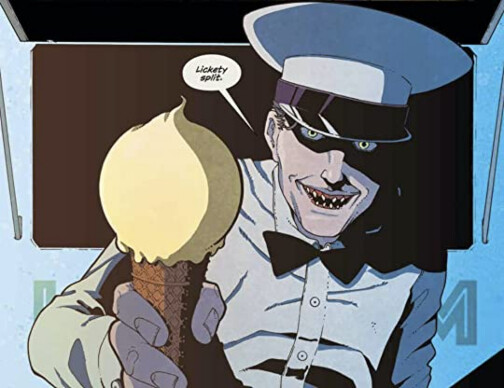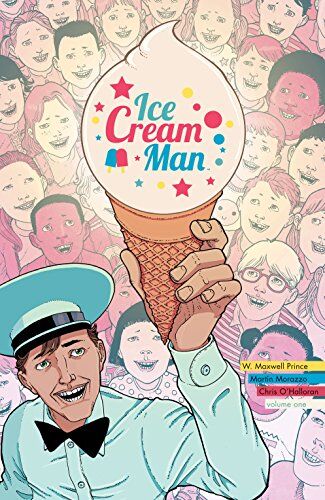Your average storybook monster is, to be sure, frightening. Your vampires, zombies, bogeymen, ghosts and ghouls are often horrifying and quite deadly. But beyond these classic creeps, I believe there’s a particularly unsettling perversion when one takes something playful or innocent and twists it to evil. When comical clowns become stalking killers. When staring dolls begin haunting households. At this point it’s an overused trope to be sure, but still one that I find truly chilling. And Ice Cream Man Volume 1 is chilling!
Puzzle Box may earn a commission when you buy through links on our site.
Yet even more disturbing and dangerous are the horrors that lurk in plain sight, hiding behind false smiles or inside the people we trust. In the real world the metaphor of “monster” drops away and the true ugliness of humanity is revealed. Murderers, rapists, pedophiles, psychopaths – even the scariest of creations don’t hold a candle to these that are both frightening and frightfully real. Give me Bigfoot over Bateman and Bates, Dracula over Dahmer and Bundy, Wendigo over Weinstein…you get the idea.
So now we come to Ice Cream Man, Volume 1. The setting is suburban, idyllic, a 1950s American Dreamland (but with more racial tolerance). Up drives the titular treat seller, playing the tune we all have engraved in our ears from when we were kids. He’s full of pleasantries and colloquialisms as he hands out all the favorite flavors. Yet something is off. There is rot beneath the sugar sweet veneer. A shadow passes over his face. The eyes turn menacing, the grin sinister. And suddenly this harmless character from our youth transforms into something much more nightmarish.

I really enjoyed my reading of this first volume in the Ice Cream Man series. Writer W. Maxwell Prince has structured it as a collection of short stories, varying in their plots yet tethered together by themes and the enigmatic Ice Cream Man. “Raspberry Surprise” is about a boy whose venomous spider has killed his parents, but he doesn’t tell anyone. “Rainbow Sprinkles” is about a pair of doped up lovers, one dying and the other distraught yet still hankering for her next fix. In “Good Ol’ Fashioned Vanilla” we see the washed up one-hit wonder Bud Hickey journey to a fantasy world full of rock legends who need his help. And finally, the last story “Every Good Boy Does Fine” is about a man giving the eulogy at his best friend’s funeral while his friend is trapped in an ever-changing hellscape.
I love how different the stories are, and yet how connected they all feel. Each story has a self-contained arc, but pervasive in all the characters is a sense of immense suffering, whether from emotional pain, boredom, regret, or loneliness. And of course there’s the otherworldly Ice Cream Man who, whether he is a main character or mostly in the background, plays some important part in each tale. He is certainly not one to be overlooked, and he doesn’t let you forget that. It’s also difficult to pin down exactly who or what he is, as he seems to shift from friend to foe and from god to demon. Regardless, what is clear is that he enjoys playing a cosmic, and often deadly, role in the lives of these suburbanites.
The art is a little different from most horror comics I’ve read, but it seems to fit the vintage-meets-surreal style the series is going for. The characters in particular are drawn in an interesting manner, with faces and features that are slightly Mike Judge meets Junji Ito.

I will say that Martin Morazzo’s sharp-lined illustrations and Chris O’Halloran’s bold colors work well together in bringing these twisted tales to life. I also particularly like the design of the pages, which usually include a full image background broken up by smaller panels of action and dialogue. It’s a fluid and integrative composition that helps give a sense of immediacy and intimacy to the story.
Ok, I’ll admit it: I’m hooked. I’ve heard the off-kilter jingle and tasted the sickly-sweet treats, and I want more. Ice Cream Man, Volume 1 is a fun and frightening collection of intertwined short stories, full of lifelike characters experiencing bizarre and unnerving turns of events. If the rest of the series is this good then we have a new pop culture icon in the making, and I need to get my hands on the next volume. Lickety Split.
Ice Cream Man, Volume 1 is available now from Image Comics.

Ben’s love for horror began at a young age when he devoured books like the Goosebumps series and the various scary stories of Alvin Schwartz. Growing up he spent an unholy amount of time binge watching horror films and staying up till the early hours of the morning playing games like Resident Evil and Silent Hill. Since then his love for the genre has only increased, expanding to include all manner of subgenres and mediums. He firmly believes in the power of horror to create an imaginative space for exploring our connection to each other and the universe, but he also appreciates the pure entertainment of B movies and splatterpunk fiction.
Nowadays you can find Ben hustling his skills as a freelance writer and editor. When he’s not building his portfolio or spending time with his wife and two kids, he’s immersing himself in his reading and writing. Though he loves horror in all forms, he has a particular penchant for indie authors and publishers. He is a proud supporter of the horror community and spends much of his free time reviewing and promoting the books/comics you need to be reading right now!

